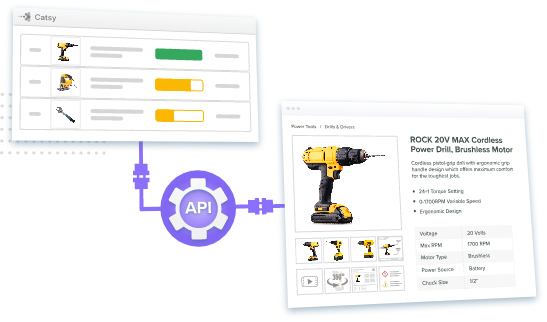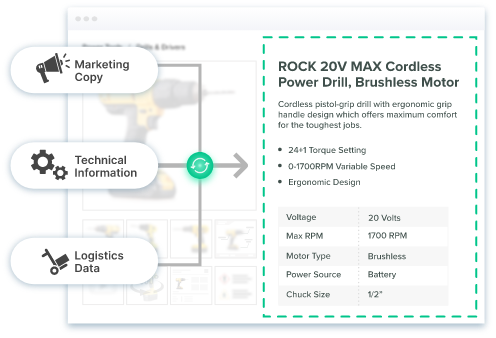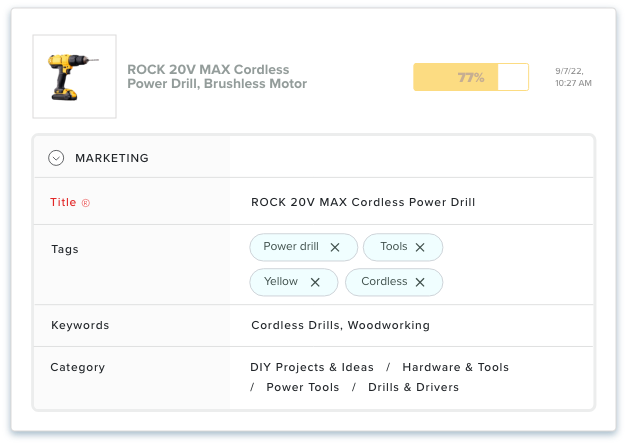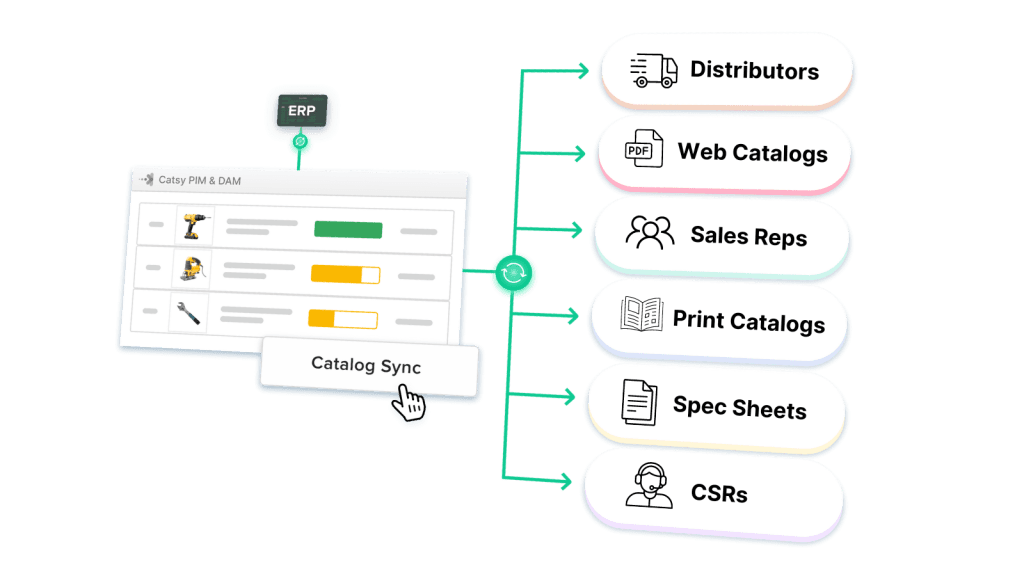How Can PIM for Manufacturers Streamline Data and Boost Success

- Many manufacturers struggle with massive, fragmented product data across systems.
- A PIM for manufacturers delivers a single source of truth to power data-driven decisions and omnichannel experiences.
- Catsy PIM provides features that enable manufacturers to accelerate speed-to-market.
In this Article
One of the highest priorities for many manufacturers is to develop a competitive advantage that protects revenues and future operations. Competitive advantage is so critical that, according to Harvard Business School’s Rebecca Karp, it may be “difficult for companies to produce and maintain sufficient returns on invested capital.”
Manufacturers can create a competitive advantage by quickly ideating, producing, and selling new products. In fact, many manufacturers use speed to market (STM) as a KPI to measure the success of a launch. However, it may be difficult to operationalize this strategy (and enjoy the benefits) if a brand lacks a robust system to manage product information.
The point is:
Most manufacturing companies today are drowning in data – product specifications, supply chain tracking information, marketing assets, etc. This data sprawl leads to significant hassles that impair achieving a favorable STM. As such, brands need a solution like product information management software (PIM) to beat out the competition.
While PIM Software may be familiar to most industrial marketers, most people don’t know its full capabilities. If this scenario sounds familiar, this article is for you.

Understanding PIM Systems: The Basics
What is a PIM Software?
A PIM software is a dashboard of tools and procedures that allow users to create, store, manipulate, enrich, and distribute details related to their products. The system lets you pull product data from various sources (ERP systems, legacy databases, supplier documents, spreadsheets, etc.) into a centralized repository. This creates a single source of truth for all product details.
This system is a critical component of a manufacturer’s data strategy. It helps to ensure that product information is accurate, consistent, and accessible across various departments, channels, and systems. Think of it as the backbone of a company’s product data management strategy.
Core functionalities of the right PIM software
Importantly, a product information management system isn’t merely a dashboard – it offers distinct and powerful functionalities crucial for manufacturers looking to create a competitive advantage. Some critical functionalities include:
- Data consolidation: Most robust product information management tools for manufacturers have specialized connectors and APIs communicating in real-time with other systems, including ERP systems. This allows you to aggregate relevant details into the centralized hub.
- Data standardization: A key feature of PIM systems is that users can create templates to govern how new product data is stored and managed. In other words, it helps standardize how product information is captured and stored. This ensures that all product details are consistent and easily understood and used by different departments and external stakeholders.
- Data enrichment: The system enhances data quality by providing tools for standardizing formats, filling in missing information, and correcting errors.
- Data governance and workflows: PIM systems establish clear rules and workflows to maintain data integrity. For instance, they allow you to allocate user roles and grant (or revoke) access. Approval processes are also part of governance, ensuring accuracy and reducing confusion throughout the management cycle.
- Multi-channel distribution: A PIM lets you tailor product data for different channels. The tools achieve this by allowing users to customize formats, descriptions, and assets to be optimal for particular product detail pages (PDPs), distributors, retailers, or even print catalogs.
- Taxonomy and classification: PIM systems allow users to create hierarchical taxonomies and categories to organize products systematically. This categorization simplifies navigation and search for both internal users and external customers. For example, a power tools manufacturer could leverage the taxonomy within the PIM to categorize SKUs by product type (e.g., drills, saws, nail guns, routers, etc.), tool lineup, or brand (e.g., Volt Max Series, Brushless Xtreme, Titanium Tools), fuel type (corded, battery-powered), or product attributes (chuck size, drill bit size, max RPMs, battery voltage, etc.). Auto-classification tools assign this standardized taxonomy to all products flowing into the PIM. For a new brushless cordless 1/2″ drill SKU, the PIM would instantly classify it under: Cordless Power Tools > Drills & Drivers > 1/2″ Drills > Brushless Motors. Auto-tagging product data in this way ensures a consistent product information architecture as the product catalog scales. It also optimizes product comparison, discovery, and faceted searches across channels.

Types of product data stored and managed by PIM
PIM is only one of the many management systems across a product’s lifecycle. Others, like product lifecycle management (PLM), take on a broader responsibility, which implies that they store and manage a wider range of details.
However, PIM is more specialized – it acts as the staging platform for information that facilitates product marketing. Some of the details you’ll find in a PIM include:
- Product identifiers (product name, brand name, SKU, GTIN, etc.)
- Technical specifications (dimensions, weight, key features, safety standards, etc.)
- Taxonomy data (product relationships, product categories, product bundles, etc.)
- Localized and region-specific content (translated text, local prices, customized images, etc.)
Some solutions, such as Catsy, are integrated with a digital asset management (DAM) management platform. This means Catsy PIM users can store and manage more product data than regular PIMs.
For example, users can view and manage digital assets without exiting the platform. The PIM and DAM system views are accessible within the same window – all you need to do is click a button to switch from PIM to digital asset management software. So, Catsy PIM can store and manage additional details like:
- Digital media assets (photos, videos, 3D/360° product images, PDF documents, etc.)
- Marketing data (testimonials, reviews, brochures, product guides, etc.)
- Compliance information (regulatory certifications, safety data sheets, etc.)

Typical Architecture of a Product Information Management or PIM System for Manufacturers
Before we go any further, it helps to understand from the onset that PIM systems can be either on-premise or cloud-based. On the one hand, on-premise solutions are installed servers over which your company has complete control. That means you have an IT team responsible for server maintenance, updates, backups, and security patches.
On the other hand, cloud-based PIMs (often called software-as-a-service SaaS) are hosted on servers that vendors own and control. Vendors like Catsy handle all the critical activities and infrastructure, including backups, security, and software updates. In return, the customer pays a recurring fee (usually monthly or annually) for using the software rather than purchasing a perpetual license.
Despite different deployment models, all PIM software has standard architectural foundations. Some critical elements include:
- Data sources: A PIM system consolidates product details from diverse sources. These can include:
- ERP systems: Source for technical specifications, inventory levels, and pricing.
- Supplier feeds: Data on new items, specifications, etc.
- Legacy systems: Older databases or spreadsheets with some relevant product information.
- Data integration: PIMs have robust Extract, Transform, Load (ETL) capabilities. The component enables the PIM to ingest data from different sources, standardize formats, and resolve conflicts.
- Data repository: At the heart of the PIM system is the database that stores all product information. Robust PIMs like Catsy have a user-friendly interface that allows teams to access and manage the information in the database. The centralized nature of this repository allows anyone with proper authorization to access the product data from any internet-connected device (which can run a browser) and location.
- Data management: This layer consists of the logic and rules that govern how data is entered, updated, and managed within the PIM system. It ensures that data is consistent, has accurate product information, and follows the organization’s standards.
- User interface: This is the front-end through which users interact with the PIM system. It allows stakeholders (merchandisers, marketers, and product managers) to work with the data without requiring deep technical knowledge. This involves efficient search, editing, and enriching of the product details.
- Output/distribution channels: This is where the power of the PIM is evident. Here, predefined and highly customizable syndication rules let you seamlessly push product data tailored to various needs. For example, Catsy PIM has specialized connectors and APIs for syndicating product information to channels such as:
- ECommerce platforms: Shopify, BigCommerce, etc.
- Distributor portals: Specific formats for your wholesale partners or B2B sales channels. Direct syndication with platforms such as AD.
- Digital catalogs: Generate production-ready data feeds.
- Third-party marketplaces: Easily syndicate data to industry-specific online platforms.
So, yes, a PIM for manufacturers will have these six elements/components regardless of the deployment model. However, it should be noted that nuances exist that may differentiate an on-premise from a cloud-based PIM. For example:
- Cloud-based systems like Catsy PIM generally offer faster and easier scalability (both increasing storage and user access) with little need for upfront hardware investment.
- On-premise PIMs for manufacturers may allow deeper customization, but this generally requires a dedicated IT team and more development time.
- In an environment with tight security standards or legacy systems, an on-premise PIM might facilitate integrations that require direct access to your private network infrastructure.
PIM for Manufacturers: Unique Features and Benefits of PIM
Centralized and accurate product data
A PIM’s most significant selling point is that it consolidates all details related to a product into a centralized hub. Individuals or organizations with proper authorization can access and manipulate this information for their benefit.
Notably, the centralized repository establishes a single source of truth, empowering data-driven decisions around the organization. For example, marketing and sales teams can access reliable, high-quality, and up-to-date information to power omnichannel experiences. This ensures that end users have the experience the product development team envisioned.
The ability to manage all product information in one place gives manufacturers a competitive edge in several ways:
- Centrally managed product data guarantees the consistency and accuracy of products. This enables manufacturers to better position themselves in the market and build trust with customers.
- Efficient data management saves costs and improves operational efficiency. It prevents resource wastage on redundant data management tasks.
- The ‘single source of truth’ principle allows manufacturers to innovate quickly. It will enable teams to leverage the wealth of information at their disposal to identify new product opportunities and improve existing ones.
- The principle also enables brands to provide a superior customer experience. This way, manufacturers can retain customers and attract new ones, increasing sales and market share.
Readiness reporting
Robust PIM solutions that are best for manufacturers promise the highest returns for manufacturers go beyond mere data storage. They provide powerful analytics into product data health, completeness, and channel readiness.
Regarding completeness, a PIM like Catsy provides completeness scoring, a feature that monitors your product data repository and determines how much information is missing. This feature identifies gaps and suggests the steps to ensure completeness. This includes adding descriptions, optimizing titles, incorporating keywords, etc.
Catsy PIM significantly allows users to establish channel-specific rules when outputting product information. PIM enables you to define rules like “required,” “optional,” and “recommended” attributes for different output channels. For example:
- Distributor portal
- Required: SKUs, wholesale pricing, detailed specifications.
- Optional: Customer-facing marketing copy.
- Recommended: 360-degree product views.
- eCommerce platform:
- Required: High-quality images, clear marketing descriptions, and search keywords.
- Optional: CAD files.
- Recommended: Lifestyle imagery, customer reviews integration.
In addition, Catsy PIM provides readiness reports that remove the guesswork from product information optimization. This feature validates that each product has the right product attributes, images, documents, pricing, and details for a specific channel. Any missing elements are flagged so product managers can fill the gaps. This prevents scrambling when new sales avenues open or incomplete product data is exported to partners.
Instant and accurate product catalog creation
With all product data in a centralized hub, creating a catalog using a PIM is a matter of a few clicks. Robust PIM solutions for manufacturers include pre-built templates, layouts, and design tools for users to create and customize product catalogs.
For example, Catsy PIM provides an automatic catalog creation feature that eliminates manual processes. The PIM automatically extracts product data from the repository and populates the catalog.
Additionally, Catsy PIM provides templates to create product catalogs quickly. The templates come in many styles and formats, allowing you to apply them as you wish.
Even better, Catsy PIM provides an Adobe InDesign add-on to streamline cross-platform workflows. This integration allows you to create new catalogs in InDesign and leverage the PIM’s product information database to populate fields. This way, all your product catalogs (digital and print) will always be up-to-date with the most accurate and complete product details.
How does instant catalog creation benefit manufacturers?
- Generating new catalogs or seasonal updates eliminates time-consuming back and forth between designers, product managers, and sales teams. This increases speed-to-market (STM) drastically.
- With data flowing directly from the PIM to your catalog, the scope for errors introduced by manual processes is reduced.
- Manufacturers and distributors can react quickly to promotions, sales, or changing costs without risking mismatched prices out on the market.
- Templates ensure a unified brand style across print and online catalogs, reinforcing professionalism.

Multiple Selling Channels
Besides centralizing product information into a single source of truth, PIM solutions’ other equally critical role is facilitating the real-time distribution of these details across diverse channels. This eliminates labor-intensive exporting, formatting, and uploading of product information for different systems.
PIM removes data friction in the following ways:
- It allows you to define each channel’s exact data format and attributes. You can adapt technical specifications for each distributor, configure optimized data feeds for eCommerce marketplaces and PDPs, and even syndicate data to industry-specific comparison sites.
- Robust PIM solutions have a syndication engine that pushes data according to established rules and schedules. Updates on prices, inventory, or product details cascade to your connected channels effortlessly.
- Most leading PIM solutions interface directly with major eCommerce platforms. For example, Catsy PIM integrates with Shopify, BigCommerce, and more, enabling seamless and real-time data transfer. The Shopify PIM tool handles complex marketplace requirements, ensures your listings comply with specific data formats, and streamlines inventory management across all platforms. Catsy PIM allows them to manage their product information across up to five different Shopify stores. This is critical for Shopify customers, mainly because the platform does not provide the means to operate multiple storefronts centrally.
Simplifying discoverability with filters
One of the most stand-out features of a PIM solution is that it raises the bar on search and discoverability. For example, Catsy PIM provides powerful filtering and faceted navigation features to simplify product searches across channels.
So, suppose a power tools manufacturer deploys Catsy PIM to help buyers discover the products they may want to purchase faster. Within the PIM system, the company categorizes products using attributes that characterize the items. For example, they annotate cordless drills with details like voltage, torque, drill bit type, clutch settings, battery type, dimensions, and weight.
The PIM solution centrally manages these attributes and syndicates them to integrated channels and systems. The PIM integrates with the search and discovery layer on the front-end eCommerce site or digital catalog. So when customers search for “cordless drill,” they can filter by the exact specifications they care about, like 18V battery power under 5 lbs. weight.
Behind the scenes, a PIM software for manufacturers powers this faceted navigation by:
- Classifying drills into precise categories
- Managing the attributes relevant to refinement
- Syndicating enriched data to the commerce layer
- Applying filtering logic based on attributes
Rather than generic keyword results, shoppers get tailored, precise results that match their needs. This simplifies and accelerates the path to finding the right products. The outcome is frictionless discovery and improved conversions.
Capturing rich content
A PIM goes beyond storing technical specifications. These details are not engaging enough and may not convince the buyer to purchase. In other words, a robust PIM solution should be able to store, manage, and distribute eye-catching visuals and engaging product descriptions.
However, the PIM solution you like does not offer this feature. This is where solutions like Catsy PIM that integrate a fully-fledged DAM software come in handy.
Catsy provides PIM and DAM functionalities – users can create, edit, and enrich product information and manage associated assets in the same window. This integration allows users to build a vast library of product images, 360-degree rotational views, spec sheets, manuals, plus video tutorials.
Catsy’s DAM system side comes with additional benefits. It lets you add and edit metadata like tags and alt-text. Notably, the PIM/DAM integration streamlines the mapping of product information with associated assets. You can do this without shuffling through application windows, an unbeatable advantage.
Conclusion
Based on this discussion, it is beyond doubt that a product data management strategy centered on a PIM system has the best odds for success. And no sector can benefit the most from such a system than manufacturing. These businesses often deal with tons of data, which grows exponentially with time.
A robust PIM ensures that manufacturers are always in complete control of the product information and can leverage it to increase sales. Precisely, a PIM platform delivers five crucial benefits:
- Centralization: Consolidating product data from all systems and stakeholders into a centralized repository. The result is a single source of truth that enforces consistency and accuracy of product information.
- Quality: A PIM tool allows you to combine overlapping data, fix errors, fill in missing details, and streamline information. This enhances data accuracy and consistency.
- Enrichment: PIM solutions that integrate digital assets management, automate classification and maximize attributes to optimize data for downstream use.
- Distribution – Seamless product data syndication across various channels, including eCommerce, marketplaces, portals, and more. This accelerates omnichannel alignment.
- Agility – Each aspect of a robust PIM solution fosters rapid response. So, new products or market opportunities don’t mean data bottlenecks. You get to market faster, keeping ahead of the competition.
Together, these value drivers reduce overhead costs while unlocking new revenue opportunities. Catsy PIM is a handy solution that promises these benefits; that’s why manufacturers are highly likely to trust it. This tool is designed for manufacturers to simplify data management complexities while improving competitiveness.
While ERPs excel at production and inventory management, they often struggle with the marketing and customer-facing aspects of product data. A PIM complements your ERP with tools for enriching descriptions, product categorization, search enhancements, and tailoring data for various sales channels.
Implementation complexity depends on the size of your product catalog, the current state of your data, and the chosen PIM solution. However, cloud-based PIM solutions are easier to set up and implement because the vendor shoulders most of the technical requirements and maintenance.
Absolutely! PIM tools offer several features that facilitate the localization of product information. For example, a PIM like Catsy allows users to implement multi-language product listings by translating the details within the platform. Also, Catsy PIM directly integrates with major marketplaces (like Amazon), ensuring your data meets their requirements and streamlining international expansion.
Nope. While PIM offers scalability for large enterprises, there are also cost-effective solutions well-suited for small to mid-size manufacturers. The benefits of data centralization and streamlined processes apply regardless of company size.
Specific ROI depends on several factors, but common areas of improvement include faster time-to-market, increased sales conversions due to enhanced product content, reduced returns from incomplete or inaccurate data, and greater team efficiency with less time spent on manual data tasks.




